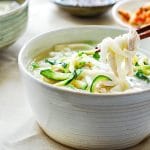Dak Kalguksu (Chicken Noodle Soup)
Delicious noodle soup made with thick knife-cut noodles and a rich chicken broth
Servings: 4
Ingredients
For the soup
- 1 small whole chicken 2.5 to 3 pounds, or bone-in pieces
- ½ medium onion
- 8 plump garlic cloves
- 3 to 4 thinly sliced ginger pieces
- 2 white parts of scallions
- 1 3- inch square dried kelp - optional
- 1 tablespoon soup soy sauce
For the chicken meat
- 1 teaspoon minced garlic
- 1 teaspoon sesame oil
- salt about 1/2 teaspoon and pepper to taste
For the vegetables
- 1/4 medium onion thinly sliced
- 1 medium zucchini, julienned julienned carrot or sliced potato is also great.
- 2 scallions finely chopped
For the noodles
- 1 package (4 servings) fresh or dried kalguksu noodles or see below for homemade noodles
For the sauce (Yangnyumjang) - Optional
- 3 tablespoons soy sauce
- 1 teaspoon sesame oil
- 1 teaspoon Korean red pepper flakes gochugaru
- 1 teaspoon sesame seeds
- 1 teaspoon minced garlic
- 2 – 3 scallions finely chopped
For the homemade noodles - Optional
- 3 cups all-purpose flour
- 3/4 teaspoon salt
- 1 tablespoon cooking oil - optional
- 1 cup water (start with 3/4 and gradually more, a tablespoon at a time until needed)
Instructions
- If making homemade noodles, see the instructions below and make the dough ahead of time. You can roll it out and cut while boiling the chicken.
- Place the cleaned chicken in a stockpot large enough to hold the chicken and 12 cups of water. Add the onion, garlic, ginger, scallions, and 12 cups water. Bring it to a boil over medium high heat. Skim off any foam on top. Reduce the heat to medium low and simmer, covered, for about 40 minutes. Adjust cooking time for cut pieces of chicken.
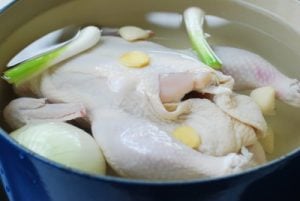
- Sprinkle the julienned zucchini with salt for about 15 minutes and then squeeze out the water.

- Cut through the thickest part of the breast, with a knife, to see if the chicken is cooked and tender. Turn the heat off and carefully remove the chicken.
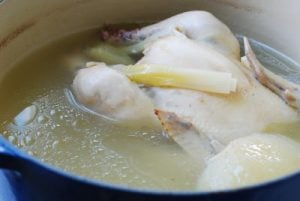
- Strain the broth and remove the excess fat. You can spoon off or use a fat separator.
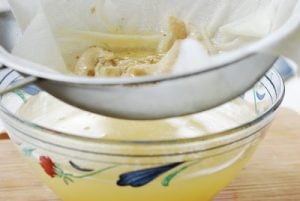
- When the chicken is cool enough to handle, remove the meat off the bones. Shred the meat into small bite size pieces. Add the garlic, salt and pepper to the chicken. Combine well.
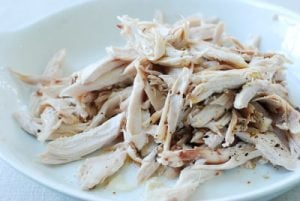
- Return the broth back to the pot. Add the soup soy sauce, onion slices, and optional dried kelp. Bring it to a boil and boil for a few minutes. Remove the kelp. Add salt and pepper to taste.
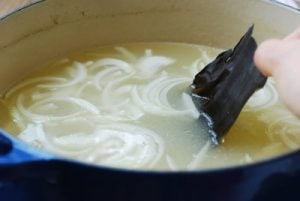
- Meanwhile, in another pot, boil water to parboil the noodles. Or the soup will get too thick. Add the noodles, and stir. Cook halfway through.

- Remove the noodles with a strainer and add to the pot with boiling broth. (This is a good time to add potato slices if using.) Continue to boil until the noodles are cooked through. Add the zucchini (and julienned carrot if using) with 2 to 3 minutes remaining.
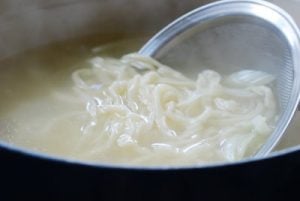
- To serve, ladle the noodles and soup in a serving bowl, top with the chicken pieces and chopped scallion.
For the homemade noodles - optional
- Mix the flour, salt, optional oil and add 3/4 water by hand until the dough starts to come together. You'll need to add more water, depending on your flour. Add 2 tablespoons water and see how it is. The dough should feel stiff to work with. If still too dry, add a little more.
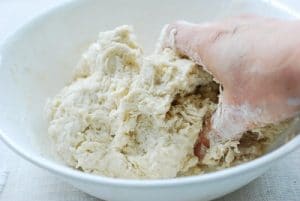
- Flour the surface to knead. Knead with the heel of your hand until the dough is fairly smooth, about 5 minutes. The dough should feel slightly too stiff to work with at this point. You can adjust the dough by kneading in a little more flour or more water (just enough to wet your hands). Cover with plastic wrap, and let it rest for 30 minutes to an hour. After resting, the dough should feel soft and smooth. You can prepare the dough up to this point a day in advance.
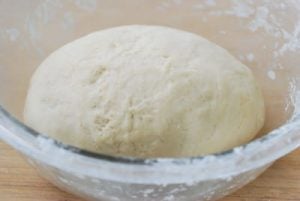
- When ready to use, knead the dough for 2 to 3 minutes. Using a sharp knife, cut the dough into 2 pieces. Dust the work surface generously with flour. Flatten a piece, and roll it out with a rolling pin to make a thin sheet, about 12 x 14-inch.
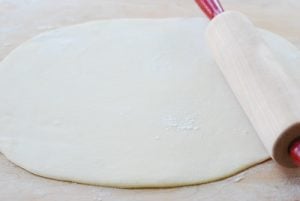
- From the longer side, fold the dough over 3 to 4 times into layers. Again, generously flour the surface and the dough as you roll it out and fold to keep the dough from sticking.
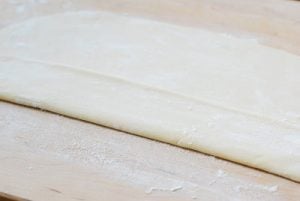
- Cut the dough with a sharp knife into about 1/4-inch thickness. Unfold the noodles and dust with flour to keep the noodle strands separate.
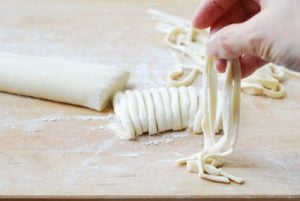
Notes
If you want to make noodles for 2 to 3 servings, use 2 cups of flour, 1/2 teaspoon of salt, 2 teaspoons of oil, and ⅔ cup of water. Basically, the ratio is, for every cup of flour, you will need 1/4 teaspoon salt, 1 teaspoon oil, and ⅓ cup of water. This may vary depending on the condition of your flour. You can always adjust the dough by kneading in a little more flour or water.
